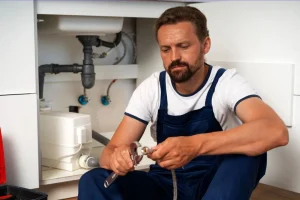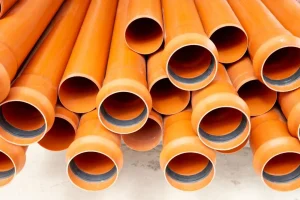Water heater low pressure is a common issue for many homeowners in Orlando and Kissimmee. This problem can impact daily routines and make simple tasks inconvenient.
Generally, sediment buildup in the tank, faulty pressure regulators, and partially closed valves can cause low water pressure. Older homes may also experience corroded pipes, further restricting water flow.
In this article, we will discuss the common reasons behind low water force from water heaters and how to fix the issue.
Potential Reasons And Solutions For Low Pressure From The Water Heater
Before getting into details, check out the table on why your water heater pressure is low with their possible solutions:
| Reasons | Possible Solutions |
| Faulty water pressure regulator | Replace the bad regulator. |
| Clogged or leaky water lines | Clean the blockages from the water lines. Fix the leaky water pipes. |
| Faulty T&P valve | Replace the faulty valve. |
| Outdated fixtures | If needed, you may need to replace the water supply system. |
| Hard water mineral buildup | Drain and flush your water heater tank. |
Why Is Your Hot Water Pressure Low?
We recommend understanding the actual reason first. Here are common reasons for low water pressure:
1. Faulty Hot Water Pressure Regulator
A malfunctioning water pressure regulator often causes low pressure. Over time, these regulators wear out, affecting water flow to your heater. When the regulator fails, it can’t maintain the desired pressure level, which results in reduced water pressure.
The issue may not always be noticeable immediately, as the drop in pressure can be gradual.
2. Clogs or Leakage in Water Lines
Clogs in pipes or water line leaks reduce water pressure. Mineral deposits or debris can obstruct water flow, causing significant pressure drops. Leaks in the water lines also lead to pressure loss.
Even minor leaks can gradually cause low hot water pressure in all taps. It will impact the performance of your water heater over time.
3. Faulty Pressure-Reducing Valve
A damaged water heater pressure relief valve may restrict water flow. These valves control water pressure and, when faulty, can lower pressure.
Pressure-reducing valves are designed to manage and maintain optimal pressure, but wear and tear can impair their functionality.
Sometimes, you may notice the water heater pressure-relief valve is leaking. This malfunction can also reduce the pressure reaching your water heater.
4. Outdated Fixtures
Old or outdated fixtures can cause low pressure. Corrosion or wear inside fixtures reduces water flow, impacting pressure significantly. Over time, fixtures may become clogged or less efficient, which restrains water flow.
It is common in homes with older plumbing systems where fixtures haven’t been updated for years.
5. Hard Water Buildup
Mineral deposits from hard water accumulate over time. These deposits clog pipes and fixtures, which reduces water pressure on your heater. Hard water contains high levels of calcium and magnesium, which form scale inside pipes and fixtures.
This buildup restricts water flow and diminishes water pressure in your water heater.
How To Increase Water Pressure In A Water Heater?
Low water pressure in your water heater can be fixed with simple steps. Here is how to fix low hot water pressure through some proactive steps:
1. Ensure the Shut-Off Valve is Fully Open
Before trying anything else, check the shut-off valve. It controls water flow into your heater. Sometimes, it might be only partially open, limiting water pressure. Turn it fully counterclockwise to ensure unrestricted water flow.
2. Flush the Water Heater Tank
Sediment and minerals accumulate at the bottom of the water heater tank gradually. It reduces the space available for water and leads to lower pressure. Flushing the tank removes these deposits and helps to restore its capacity and improve water flow.
To flush the tank:
- Turn off the power supply to the heater.
- Attach a garden hose to the drain valve at the bottom of the tank.
- Place the other end of the hose in a suitable drainage area.
- Open the pressure relief valve and then the drain valve to release water.
- Let the tank drain completely, then close both valves.
- Refill the tank with cold water and let it run until clear water comes out of the drain hose.
- Close the drain valve and turn the power supply back on.
2. Replace the Pressure Regulator
You can find it near the main water supply line where it enters your home, often in the basement or utility area. Make sure to turn off the main water supply before checking it.
Attach a pressure gauge to a hose bib or faucet after the regulator to measure the water pressure. Compare the gauge reading to the recommended pressure levels for your area. If the pressure is consistently low, the regulator may be defective. In that case, consider replacing it to ensure optimal water pressure.
3. Clean the Blockages in the Water Lines
If the water pressure regulator is okay, it is time to inspect your plumbing system for any clogs, sediment, or debris.
Use a plumbing snake or pipe cleaning solution to remove blockages and restore proper water flow. Or, you can seek help from a professional plumber like ASAP Service Plumbing, offering water heater replacement service in Orlando.
4. Replace Corroded Pipes
Corroded pipes restrict water flow and can contribute to low water pressure. Inspect your pipes regularly for signs of corrosion, such as rust, discoloration, or visible leaks.
If you notice any indications of corrosion, consider replacing the affected pipes with new ones constructed from corrosion-resistant materials.
Upgrading pipes will improve water flow and pressure. It will also enhance the longevity and reliability of your water heater system.
When To Call In The Water Heater Plumbing Experts?
If you’ve tried basic troubleshooting steps and found no result, it’s time to call in the experts. Persistent low-pressure water in your water heater may indicate underlying issues such as extensive pipe blockages or heater malfunctions.
It’s best to hire professionals if you’re inexperienced with plumbing repairs or suspect complex issues. Find reliable water heater replacement services in Orlando or Kissimmee that have experience diagnosing and fixing water heater problems. They will ensure efficient and lasting solutions for your home’s plumbing system.
In Closing!
Fixing water heater low-pressure issues involves identifying and addressing issues like sediment growth, faulty pressure regulators, and corroded pipes. By taking care of these common problems, you can improve the reliability and performance of your water heater.
Also, regular maintenance and timely professional inspections are key to maintaining good water pressure and ensuring your water heater works efficiently. Contact us for a permanent solution to low pressure from the water heater.
Frequently Asked Questions!
How often should I flush my water heater to prevent low-pressure issues?
Flush your water heater annually to prevent sediment from forming and maintain optimal pressure. Regular flushing not only removes debris but also ensures efficient performance and extends the lifespan of your water heater.
Can low water pressure damage my water heater?
Yes, low water pressure can damage your water heater. If the pressure is too low, the heating element may not be completely submerged in water, which can cause it to overheat and burn out.
What should be the minimum water pressure from my water heater?
The minimum water pressure from your water heater should be at least 20 pounds per square inch (psi) to meet most codes. However, ideally, it should be between 40 to 45 psi for optimal performance. Pressures below 30 psi are considered too low.




